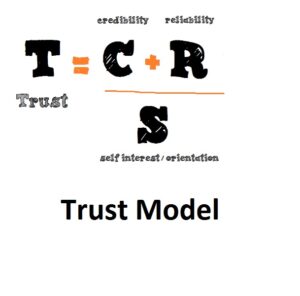Trust: The ultimate sales relationship tool
A lifetime to build but can be lost in a second
“How much money do you earn a year?” “When are you planning to retire?” “When are you going to propose to her?”
Could you even imagine asking these questions at a social gathering, the first time you met someone? Of course not! We would be avoided like the plague. So, why then, do we expect our customer or prospect to answer similar questions before we ever really get to know them?
“What is your breakeven on corn?” “What is your death loss rate?” “How much do you pay for product XYZ?”
Are these good questions? Absolutely! Do we want to know the answers if we are selling to this producer? Absolutely! Will these answers help us sell better? Again, absolutely!
So then, how do we get to a point where we can ask these high-value questions?
By developing the ultimate tool in your sales tool shed: Trust
Why? Because trust leads to our customer’s ability to be open and candid with us. When a customer trusts us, they are willing to share information that helps us sell to them. I said sell to them, not manipulate them into buying. There’s a difference, obviously. And we’ll dig into how that difference is determined, by your customer.
But first, you need to understand the interesting and sometimes painful truths about trust. As Stephen Covey told us in his book, The Seven Habits of Highly Effective People, “Trust is developed like an Emotional Bank Account”. You make deposits and withdrawals over time. It starts out with a zero balance. When you meet a prospect, your Trust Account with them is pretty close to zero, depending on you and your company’s reputation. Over time, with plenty of deposits, you can begin to ask more and more high-value questions. Your customer/prospect trusts you more and more. With this trust comes great responsibility. You must use it in their best interest.
Last point before we talk about how to develop trust. Trust is built over a lifetime and can be lost in seconds. Look no further than the headlines of your local news source. Coaches and public leaders that we knew and trusted for years or decades, gone in seconds because of their actions or behaviors. Guard your emotional bank account- your built-up trust – as if it’s a prized possession because it is.
You might be thinking, “Well that’s all great, but how do we build trust and more importantly, how do we build it faster?” or “Great, but I don’t have a lifetime to build up the Trust Account. I need to get something sold!”
Perfect, let’s look at the Trust Model to get a better understanding of what your prospect goes through when you walk in the door.
 Trust is boiled down to an instantaneous math equation that your customer runs through in their mind when they think of us. The components are:
Trust is boiled down to an instantaneous math equation that your customer runs through in their mind when they think of us. The components are:
- Credibility: Your prospect determines quickly whether you are credible or not. Is your expertise, your data, your knowledge of their operation competent enough to put trust in you. Think of this example on medical advice. Which has more credibility, the National Enquirer or the American Journal of the Medical Science? Hopefully, we trust the AJMA. So, we put more trust in their words. Your customer does the same thing with you.
- Most salespeople spend a lot of time focusing on this area as they desperately want to appear as the subject matter expert. They dig deep on the research & technical side of their products. I understand this desire but don’t neglect the other parts of the Trust Model.
- What to do if I don’t have credibility? Maybe you are brand new in your job or brand new with the company and you don’t have the years of experience to draw credibility from. Bring in your support team and your connections. Pull from your company resources, your experienced peers that can help boost your credibility with your customer, your technical and research teams that can support you. Look for industry leaders that support your ideas. Bring their research and opinions to your customer until you have your own experiences to draw from.
- Reliability: This is table stakes for being in business. You have to do what you say you will do when you said you would do it. Anything else kills the trust your customer bestows upon you. Your customer is too busy to deal with unreliable vendors.
- The Denominator: Self Interest Orientation: As you know, if the denominator is zero, the answer to this equation is always zero. So, this part of the equation is critical to all others. We are all born with the fight or flight mechanism in our brain. In today’s world, we use that mechanism to quickly pass judgment on people as first impressions. You make the decision within seconds of meeting someone whether or not they are friend or foe. In a sales relationship, your customer makes that same decision on whether you are there to help him or just there to make a sale. Don’t get me wrong on this point. We are all in sales and that is what we are getting paid to do. There’s nothing wrong with wanting to grow your business and to make a sale. However, the sale has to be in the customer’s best interest. If not, they will pick up on it quickly and trust will remain low.
Now that you understand the Trust Model math equation, it’s time to start making deposits and stop making withdrawals.
Trust Deposits
- Be on time
- Be prepared
- Do what you said you would do – take good notes when you meet so you don’t forget.
- Honor the absent – don’t badmouth anyone, even your competition unless they are there to defend themselves
- Be interested: in them and their entire farm operation or company, not just the part you sell to.
- Admit mistakes! Correct them! And don’t make a habit of making them again.
- Be open and honest, but that doesn’t mean you have to tell them everything. For example, I loved explaining some of the behind the scenes thought process that goes into running a feed or grain business. However, formulas and margins are confidential and obviously not up for discussion.
- Make it right. I know the contract says this or that, but if it’s not truly what was meant or intended, then make it right.
Trust Withdrawals
- Exaggerating to cover up mistakes or make a sale
- Forcing a product to fit the customer’s need. Yes, you have to believe in your products. However, I’ve seen more than my share of people that lose credibility with a customer because they over promote one product to every customer. Kind of like when you’re 10 and you get a hammer for your birthday. Everything you see is a nail. Our adult version in sales is, you had success selling the Triple A+ Fainting Goat Feed. That doesn’t mean every fainting goat has to eat your product.
- Not admitting your problems or mistakes. Your customer sees them and knows them. You may as well just admit them and let them know you are in the process of fixing them.
- Self-oriented behavior: WIIFTC: What’s in it for the customer. Always ask WIIFTC before any recommendation, any sales presentation, any meeting – pretty much any interaction with your customer. Also, on this point, you will have those moments in your sales career when you have to explain a new policy or procedure or pricing program, etc. This new program may not be in the customer’s best interest. Examples: new credit terms with a higher interest rate, a price increase, discontinuing a program that was a really good deal for the customer, a production shut down that will inconvenience your customer. These are all things that don’t have a positive WIIFTC. They are most likely out of your control. My method of dealing with them was to confront it head-on. I didn’t make apologies or excuses. I opened with the exact changes. If it was to eliminate a business loss on our part, I explained how we lost money on it, etc. I also didn’t slip it into the conversation. If I knew it was important to the customer, I told them so. However, I told them we were changing. Sometimes, the customer became angry and felt my company or I was being self-centered. While that was most likely true, I was now relying on all the years of deposits in the trust account to continue doing business with them.
- In a sales career, you or your company are going to violate one of the above. It happens. Fix it/Make it right. Lastly, don’t make it a habit or your trust account will go to zero.
Benefits of Trust:
- Faster Selling
- More efficient selling process – you don’t play as many games
- Better answers to your high-value questions
- Better solutions to your customer’s needs
- True win-win relationships and not thinly disguised win-lose or lose-win relationships
- Flexibility to make mistakes and recover – for both customer and salesperson. Ever forget to dot an I or cross a T and your customer or vendor sticks you with the error? Trust goes to zero and so does your future business with them.
Rebuilding when trust is lost
Join me next week as I dig into the difficult world of rebuilding trust. It’s tough enough to build it from the ground up. But, now you or your company dug yourself into a hole. You violated the customer’s trust in their opinion and you have the arduous journey of climbing that mountain all over again.
If you found this article helpful in any way, please feel free to share it with someone who might also enjoy it. While these articles are heavily agribusiness oriented, they truly fit within many industries. I’m always amazed when I find out how similar our industry is to others and how these articles resonate with them as well.
One of the great ways I get to share my message and stories with the agribusiness community is through speaking at company sales meetings and association events. While I enjoy talking on the sales topics in breakout sessions, I had the recent privilege of developing a keynote presentation titled,
“They Need You Now, More Than Ever Before” – It’s a compilation of stories and how-to strategies that your sales team can use to help producers during the tough ag economy we are in. It’s a 60-90-minute presentation that has an active take-home exercise to increase accountability to take action on the 7 strategies presented. It’s a message for anyone in the company and definitely needed at this time in the ag industry. If you have an event coming up or would like to see if it’s a fit for your meeting, reach out at Greg@GregMartinelli.net




